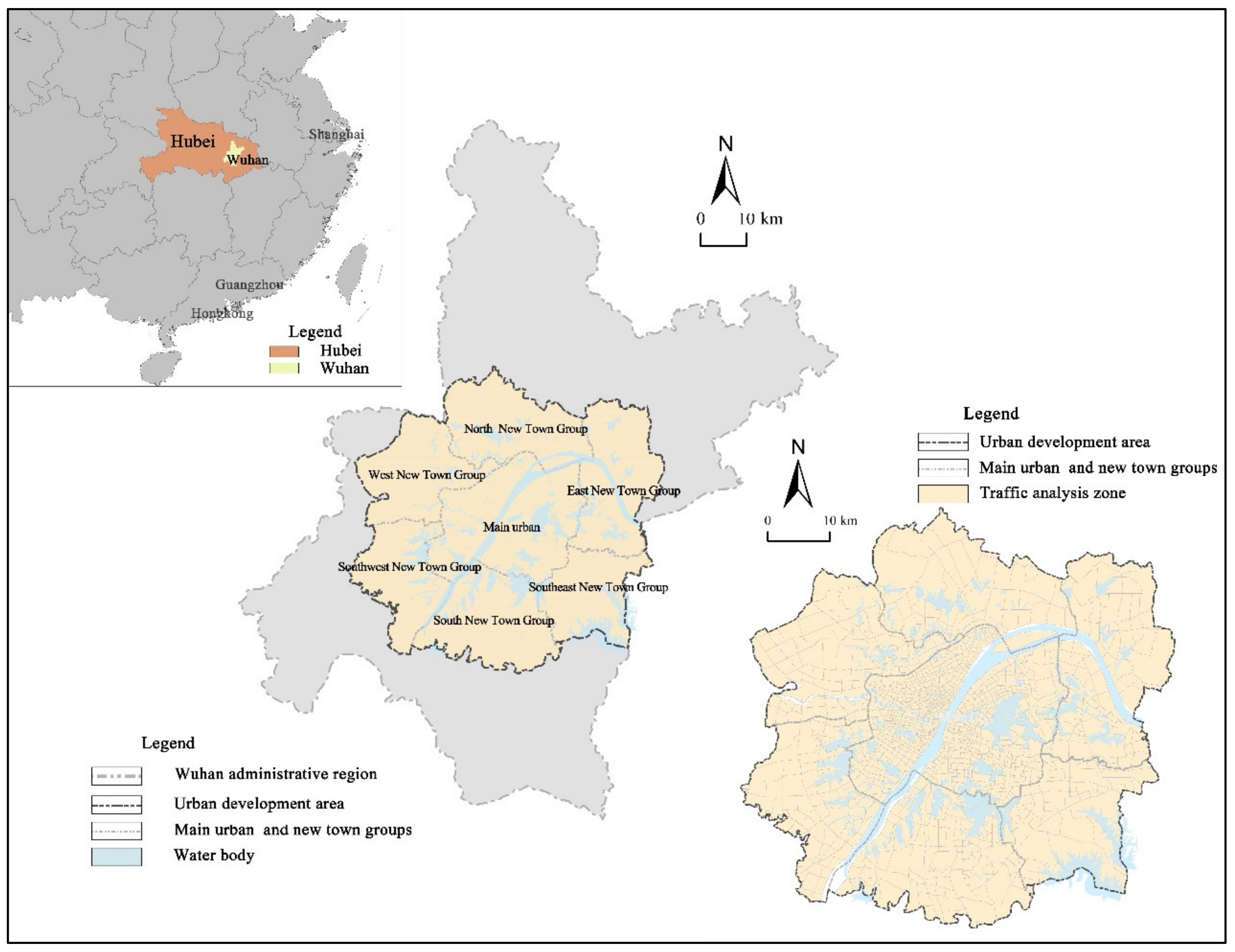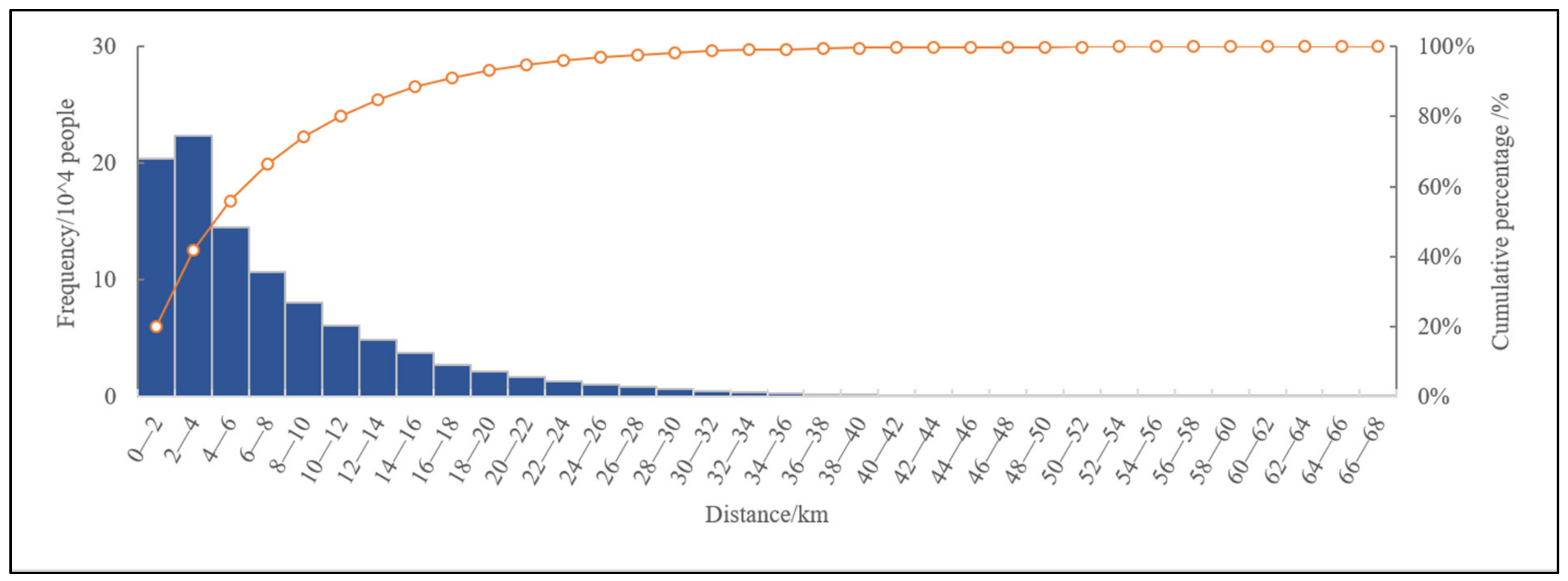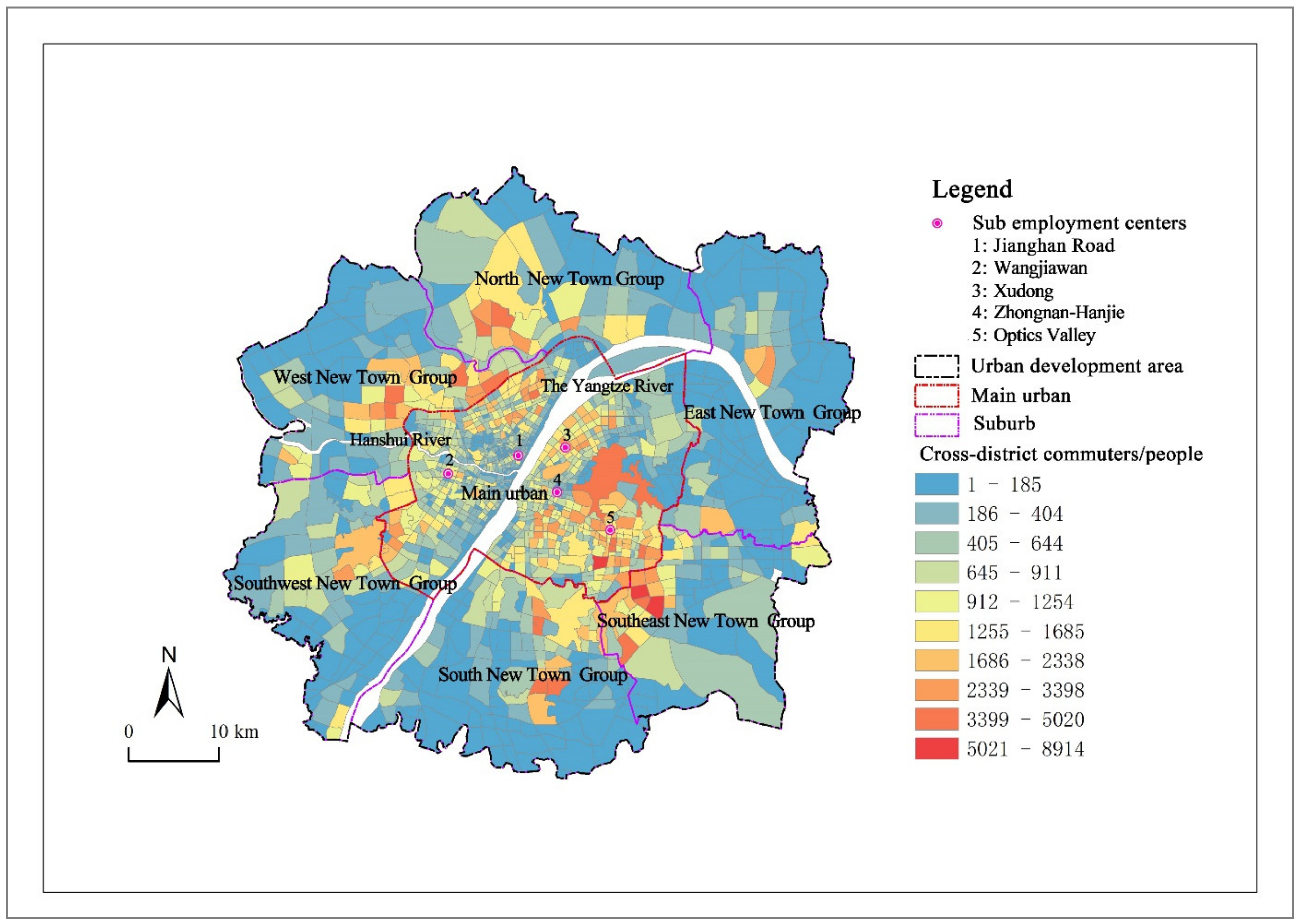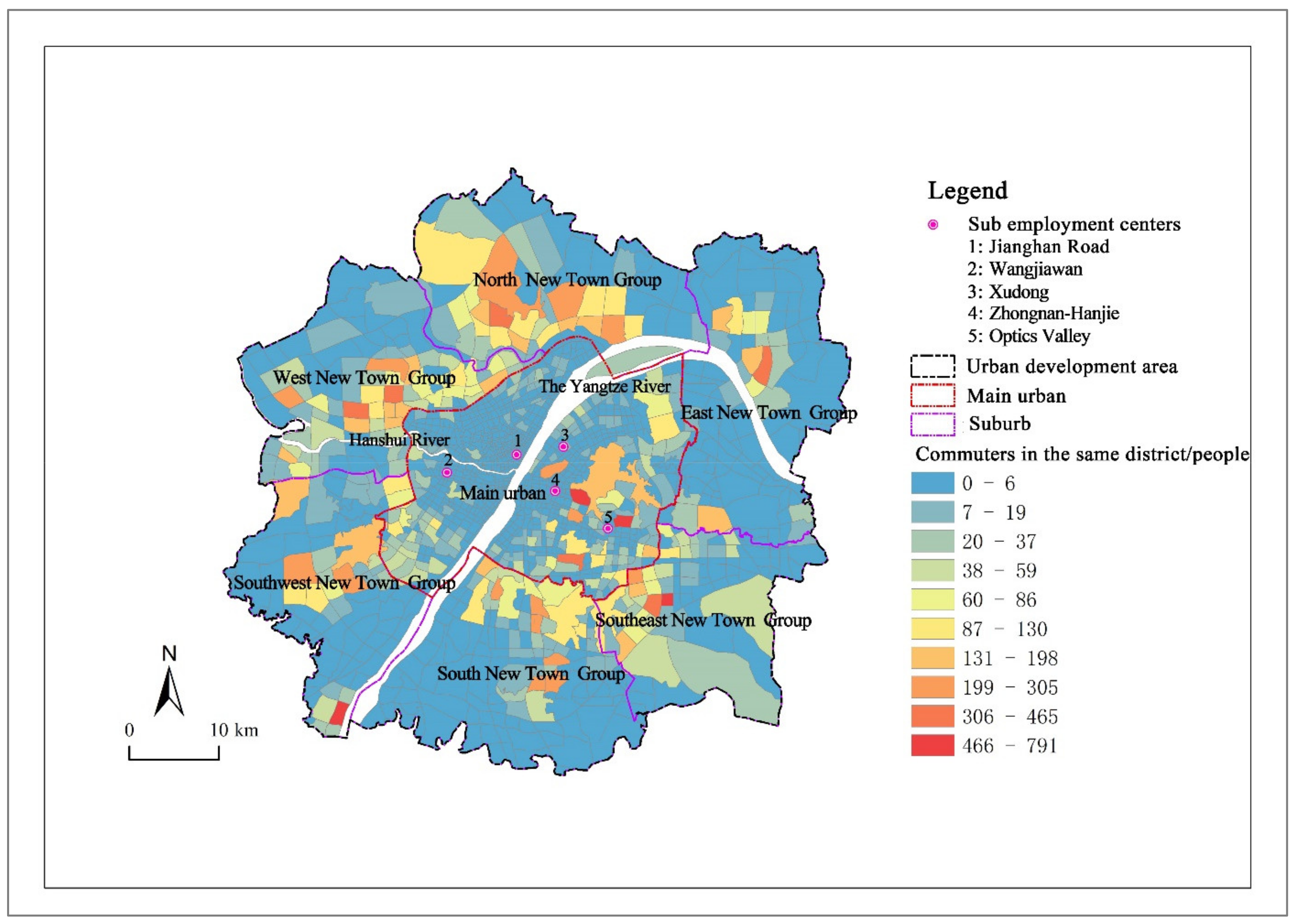Influences of Built Environment at Residential and Work Locations on Commuting Distance: Evidence from Wuhan, China
Abstract
:1. Introduction
2. Literature Review
- (1)
- In addition to the impacts of the built environment in residential locations on residents’ commuting behavior, the built environment’s characteristics at job locations also have a significant impact on residents’ commuting behavior. However, few studies have attempted to explore the impact of the built environment at job locations. Understanding the impact of the built environment in both residential and job locations on commuting distances can better guide the optimization of the built environment and the formulation of related policies at the micro level.
- (2)
- Although studies have focused on the interaction between the built environment and travel behavior, little is known about the relevant relationship in polycentric cities. In addition, the findings of studies on the impact of monocentric versus polycentric cities on commuting are not in agreement. Compared to other cities, Wuhan has a unique polycentric pattern of two rivers (the Yangtze and Hanshui Rivers) and three towns (Wuchang, Hankou, and Hanyang) due to the natural landscape pattern. Separated by these two rivers, Wuhan has a unique cross-river commuting behavior and commuters travel a relatively long distance.
3. Research Design
3.1. Study Area
3.2. Method
3.3. Data Sources and Description
4. Results and Discussion
5. Conclusions
Author Contributions
Funding
Institutional Review Board Statement
Informed Consent Statement
Data Availability Statement
Conflicts of Interest
References
- Hu, L.; Sun, T.; Wang, L. Evolving urban spatial structure and commuting patterns: A case study of Beijing, China. Transp. Res. Part D Transp. Environ. 2018, 59, 11–22. [Google Scholar] [CrossRef]
- Ewing, R.; Cervero, R. Travel and the built environment. J. Am. Plan. Assoc. 2010, 76, 265–294. [Google Scholar] [CrossRef]
- Ewing, R.; Cervero, R. Travel and the Built Environment: A Synthesis. Transp. Res. Rec. 2001, 87–114. [Google Scholar] [CrossRef] [Green Version]
- Ding, C.; Mishra, S.; Lu, G.; Yang, J.; Liu, C. Influences of built environment characteristics and individual factors on commuting distance: A multilevel mixture hazard modeling approach. Transp. Res. Part D Transp. Environ. 2017, 51, 314–325. [Google Scholar] [CrossRef]
- Manaugh, K.; Miranda-Moreno, L.F.; El-Geneidy, A.M. The effect of neighbourhood characteristics, accessibility, home-work location, and demographics on commuting distances. Transportation 2010, 37, 627–646. [Google Scholar] [CrossRef]
- Guo, J.Y.; Chen, C. The built environment and travel behavior: Making the connection. Transportation 2007, 34, 529–533. [Google Scholar] [CrossRef]
- Handy, S. Is accessibility an idea whose time has finally come? Transp. Res. Part D Transp. Environ. 2020, 83, 102319. [Google Scholar] [CrossRef]
- Yang, L.; Ding, C.; Ju, Y.; Yu, B. Driving as a commuting travel mode choice of car owners in urban China: Roles of the built environment. Cities 2021, 112, 103114. [Google Scholar] [CrossRef]
- Ye, R.; Titheridge, H. Satisfaction with the commute: The role of travel mode choice, built environment and attitudes. Transp. Res. Part D Transp. Environ. 2017, 52, 535–547. [Google Scholar] [CrossRef]
- Ding, C.; Cao, X. How does the built environment at residential and work locations affect car ownership? An application of cross-classified multilevel model. J. Transp. Geogr. 2019, 75, 37–45. [Google Scholar] [CrossRef]
- Bai, X.; Zhai, W.; Steiner, R.L.; He, Z. Exploring extreme commuting and its relationship to land use and socioeconomics in the central Puget Sound. Transp. Res. Part D Transp. Environ. 2020, 88, 102574. [Google Scholar] [CrossRef]
- Chen, E.; Ye, Z.; Bi, H. Incorporating smart card data in spatio-temporal analysis of metro travel distances. Sustainability 2019, 11, 7069. [Google Scholar] [CrossRef] [Green Version]
- Efron, B. Bayes’ theorem in the 21st century. Science 2013, 340, 1177–1178. [Google Scholar] [CrossRef] [PubMed]
- Lombardo, L.; Cama, M.; Conoscenti, C.; Märker, M.; Rotigliano, E. Binary logistic regression versus stochastic gradient boosted decision trees in assessing landslide susceptibility for multiple-occurring landslide events: Application to the 2009 storm event in Messina (Sicily, southern Italy). Nat. Hazards 2015, 79, 1621–1648. [Google Scholar] [CrossRef]
- Yang, L.; Liu, J.; Liang, Y.; Lu, Y.; Yang, H. Spatially varying effects of street greenery on walking time of older adults. ISPRS Int. J. Geo-Information 2021, 10, 596. [Google Scholar] [CrossRef]
- Cervero, R. Alternative approaches to modeling the travel-demand impacts of smart growth. J. Am. Plan. Assoc. 2006, 72, 285–295. [Google Scholar] [CrossRef]
- Zhao, P. The Impact of the Built Environment on Individual Workers’ Commuting Behavior in Beijing. Int. J. Sustain. Transp. 2013, 7, 389–415. [Google Scholar] [CrossRef]
- Ding, C.; Lin, Y.; Liu, C. Exploring the influence of built environment on tour-based commuter mode choice: A cross-classified multilevel modeling approach. Transp. Res. Part D Transp. Environ. 2014, 32, 230–238. [Google Scholar] [CrossRef]
- Kemperman, A.; Timmerman, H. Influences of built environment on walking and cycling by latent segments of aging population. Transp. Res. Rec. 2009, 2134, 1–9. [Google Scholar] [CrossRef]
- Kuby, M.; Barranda, A.; Upchurch, C. Factors influencing light-rail station boardings in the United States. Transp. Res. Part A Policy Pract. 2004, 38, 223–247. [Google Scholar] [CrossRef]
- Cervero, R.; Kockelman, K. Travel demand and the 3Ds: Density, diversity, and design. Transp. Res. Part D Transp. Environ. 1997, 2, 199–219. [Google Scholar] [CrossRef]
- Bezirgani, A.; Lachapelle, U. Online grocery shopping for the elderly in Quebec, Canada: The role of mobility impediments and past online shopping experience. Travel Behav. Soc. 2021, 25, 133–143. [Google Scholar] [CrossRef]
- Böcker, L.; van Amen, P.; Helbich, M. Elderly travel frequencies and transport mode choices in Greater Rotterdam, the Netherlands. Transportation 2017, 44, 831–852. [Google Scholar] [CrossRef] [Green Version]
- Spinney, J.E.L.; Scott, D.M.; Newbold, K.B. Transport mobility benefits and quality of life: A time-use perspective of elderly Canadians. Transp. Policy 2009, 16, 1–11. [Google Scholar] [CrossRef]
- Zhang, M. The role of land use in travel mode choice: Evidence from Boston and Hong Kong. J. Am. Plan. Assoc. 2004, 70, 344–360. [Google Scholar] [CrossRef]
- Sun, B.; Ermagun, A.; Dan, B. Built environmental impacts on commuting mode choice and distance: Evidence from Shanghai. Transp. Res. Part D Transp. Environ. 2017, 52, 441–453. [Google Scholar] [CrossRef]
- Ding, C.; Cao, X.; Liu, C. How does the station-area built environment influence Metrorail ridership? Using gradient boosting decision trees to identify non-linear thresholds. J. Transp. Geogr. 2019, 77, 70–78. [Google Scholar] [CrossRef]
- Yang, J.; Su, P.; Cao, J. On the importance of Shenzhen metro transit to land development and threshold effect. Transp. Policy 2020, 99, 1–11. [Google Scholar] [CrossRef]
- Vasanen, A. Functional Polycentricity: Examining Metropolitan Spatial Structure through the Connectivity of Urban Sub-centres. Urban Stud. 2012, 49, 3627–3644. [Google Scholar] [CrossRef]
- Hu, L.; Yang, J.; Yang, T.; Tu, Y.; Zhu, J. Urban Spatial Structure and Travel in China. J. Plan. Lit. 2020, 35, 6–24. [Google Scholar] [CrossRef]
- Lin, T.; Xia, J.; Robinson, T.P.; Goulias, K.G.; Church, R.L.; Olaru, D.; Tapin, J.; Han, R. Spatial analysis of access to and accessibility surrounding train stations: A case study of accessibility for the elderly in Perth, Western Australia. J. Transp. Geogr. 2014, 39, 111–120. [Google Scholar] [CrossRef] [Green Version]
- Truong, L.T.; Somenahalli, S.V.C. Exploring frequency of public transport use among older adults: A study in Adelaide, Australia. Travel Behav. Soc. 2015, 2, 148–155. [Google Scholar] [CrossRef]
- Szeto, W.Y.; Yang, L.; Wong, R.C.P.; Li, Y.C.; Wong, S.C. Spatio-temporal travel characteristics of the elderly in an ageing society. Travel Behav. Soc. 2017, 9, 10–20. [Google Scholar] [CrossRef] [Green Version]
- Wong, R.C.P.; Szeto, W.Y.; Yang, L.; Li, Y.C.; Wong, S.C. Public transport policy measures for improving elderly mobility. Transp. Policy 2018, 63, 73–79. [Google Scholar] [CrossRef] [Green Version]
- Xiao, W.; Li, H.; Wei, Y.D. Understanding jobs-housing imbalance in urban China: A case study of Shanghai. J. Transp. Land Use 2021, 14, 389–415. [Google Scholar] [CrossRef]
- Ding, C.; Cao, X.; Wang, Y. Synergistic effects of the built environment and commuting programs on commute mode choice. Transp. Res. Part A Policy Pract. 2018, 118, 104–118. [Google Scholar] [CrossRef]
- Antipova, A.; Wang, F.; Wilmot, C. Urban land uses, socio-demographic attributes and commuting: A multilevel modeling approach. Appl. Geogr. 2011, 31, 1010–1018. [Google Scholar] [CrossRef]
- Cao, J. Examining the Relationship Between Neighborhood Built Environment and Travel Behavior: A Review from the US Perspective. Urban Plan. Int. 2015, 30, 46–52. [Google Scholar]
- Ding, C.; Cao, X.; Næss, P. Applying gradient boosting decision trees to examine non-linear effects of the built environment on driving distance in Oslo. Transp. Res. Part A Policy Pract. 2018, 110, 107–117. [Google Scholar] [CrossRef]
- Yang, J.; Cao, J.; Zhou, Y. Elaborating non-linear associations and synergies of subway access and land uses with urban vitality in Shenzhen. Transp. Res. Part A Policy Pract. 2021, 144, 74–88. [Google Scholar] [CrossRef]




| Variable | Description | Average | SD | |
|---|---|---|---|---|
| Residential Built Environment Factors at the TAZ Level | ||||
| Density | Residential density | Ratio of resident population obtained through cellular signaling data to TAZ (persons/km2). | 6056.04 | 4921.28 |
| Employment density | Ratio of employed population obtained through cellular signaling data to TAZ (persons/ km2) | 2150.34 | 2281.77 | |
| Plot ratio | Plot ratio of each TAZ calculated through the building vector data of Wuhan. | 0.46 | 1.87 | |
| Diversity | Land use mix | where S is the land use mix; k is the classification data of land use types; is the proportion of land area in category I, | 0.55 | 0.15 |
| Design | Number of intersections | Number of intersections in each TAZ | 24.00 | 30.10 |
| Parking service level | Number of parking lots in each TAZ | 17.95 | 19.25 | |
| Destination | Number of companies | Number of corporate POIs in each TAZ | 55.89 | 78.18 |
| Distance | Distance to sub employment centers | Calculate the straight-line distance of individual residence from five employment centers in Wuhan (As shown in Figure 3, Jianghan Road, Wangjiawan, Xudong, Zhongnan-Hanjie, Optics Valley), and choose the smallest distance (km) | 7162.21 | 5628.51 |
| Number of metro stations | Number of metro stations in each TAZ | 0.21 | 0.48 | |
| Number of bus stops | Number of bus stops in each TAZ | 4.38 | 5.79 | |
| Workplace built environment factors at the TAZ level | ||||
| Density | Residential density | Ratio of population obtained through cellular signaling data to TAZ (persons/km2). | 6020.68 | 5094.84 |
| Employment density | Ratio of employed population obtained through cellular signaling data to TAZ (persons/ km2) | 3236.79 | 3582.7 | |
| Plot ratio | Plot ratio of each TAZ calculated through the building vector data of Wuhan. | 0.44 | 1.31 | |
| Diversity | Land use mix | where S is the land use mix; k is the classification data of land use types; is the proportion of land area in category I, | 0.55 | 0.16 |
| Design | Number of intersections | Number of intersections in each TAZ | 23.83 | 30.18 |
| Parking service level | Number of parking lots in each TAZ | 20.10 | 22.80 | |
| Destination | Number of companies | Number of corporate POIs in each TAZ | 74.49 | 98.75 |
| Distance | Distance to sub employment centers | Calculate the straight-line distance of individual residence from five employment centers in Wuhan (As shown in Figure 3, Jianghan Road, Wangjiawan, Xudong, Zhongnan-Hanjie, Optics Valley), and choose the smallest distance (km) | 6987.51 | 5904.79 |
| Number of metro stations | Number of metro stations in each TAZ | 0.22 | 0.48 | |
| Number of bus stops | Number of bus stops in each TAZ | 4.02 | 6.01 | |
| Parameter | Median | 95%CI | pd | ROPE | ROPE_CI | Rhat | ESS |
|---|---|---|---|---|---|---|---|
| Residential Built Environment Factors at the TAZ Level | |||||||
| Residential density | −0.01 | [−0.02, −0.01] | 100% | [−718.15, 718.15] | 100% | 1.00 | 2370 |
| Employment density | −0.00 | [−0.01, 0.01] | 81.03% | [−718.15, 718.15] | 100% | 1.00 | 2453 |
| Plot ratio | 24.34 | [16.85, 31.73] | 100% | [−718.15, 718.15] | 100% | 1.00 | 10,833 |
| Land use mix | −196.47 | [−288.60, −107.42] | 100% | [−718.15, 718.15] | 100% | 1.00 | 7292 |
| Number of intersections | −7.02 | [−7.54, −6.48] | 100% | [−718.15, 718.15] | 100% | 1.00 | 5757 |
| Parking service level | −4.28 | [−5.23, −3.34] | 100% | [−718.15, 718.15] | 100% | 1.00 | 4069 |
| Number of companies | −1.18 | [−1.39, −0.96] | 100% | [−718.15, 718.15] | 100% | 1.00 | 4575 |
| Distance to sub employment centers | 0.07 | [0.07, 0.08] | 100% | [−718.15, 718.15] | 100% | 1.00 | 3218 |
| number of metro stations | 169.47 | [141.91, 197.76] | 100% | [−718.15, 718.15] | 100% | 1.00 | 7330 |
| number of bus stops | 20.91 | [17.57, 24.01] | 100% | [−718.15, 718.15] | 100% | 1.00 | 3877 |
| Workplace built environment factors at the TAZ level | |||||||
| Residential density | 0.00 | [−0.00, 0.01] | 96.33% | [−718.15, 718.15] | 100% | 1.00 | 3105 |
| Employment density | 0.10 | [0.09, 0.10] | 100% | [−718.15, 718.15] | 100% | 1.00 | 3555 |
| Plot ratio | 4.40 | [−6.53, 14.84] | 78.22% | [−718.15, 718.15] | 100% | 1.00 | 9154 |
| Land use mix | −825.29 | [−913.29, −734.31] | 100% | [−718.15, 718.15] | 0% | 1.00 | 8841 |
| Number of intersections | 5.18 | [4.65, 5.71] | 100% | [−718.15, 718.15] | 100% | 1.00 | 5345 |
| Parking service level | −17.68 | [−18.53, −16.88] | 100% | [−718.15, 718.15] | 100% | 1.00 | 4267 |
| Number of companies | −0.82 | [−0.99, −0.65] | 100% | [−718.15, 718.15] | 100% | 1.00 | 4176 |
| Distance to sub employment centers | 0.21 | [0.20, 0.21] | 100% | [−718.15, 718.15] | 100% | 1.00 | 2930 |
| number of metro stations | 84.77 | [54.35, 114.28] | 100% | [−718.15, 718.15] | 100% | 1.00 | 8576 |
| number of bus stops | 27.25 | [24.54, 30.22] | 100% | [−718.15, 718.15] | 100% | 1.00 | 5344 |
Publisher’s Note: MDPI stays neutral with regard to jurisdictional claims in published maps and institutional affiliations. |
© 2022 by the authors. Licensee MDPI, Basel, Switzerland. This article is an open access article distributed under the terms and conditions of the Creative Commons Attribution (CC BY) license (https://creativecommons.org/licenses/by/4.0/).
Share and Cite
Yan, X.; Zhou, J.; Sheng, F.; Niu, Q. Influences of Built Environment at Residential and Work Locations on Commuting Distance: Evidence from Wuhan, China. ISPRS Int. J. Geo-Inf. 2022, 11, 124. https://doi.org/10.3390/ijgi11020124
Yan X, Zhou J, Sheng F, Niu Q. Influences of Built Environment at Residential and Work Locations on Commuting Distance: Evidence from Wuhan, China. ISPRS International Journal of Geo-Information. 2022; 11(2):124. https://doi.org/10.3390/ijgi11020124
Chicago/Turabian StyleYan, Xuexin, Jie Zhou, Fubin Sheng, and Qiang Niu. 2022. "Influences of Built Environment at Residential and Work Locations on Commuting Distance: Evidence from Wuhan, China" ISPRS International Journal of Geo-Information 11, no. 2: 124. https://doi.org/10.3390/ijgi11020124
APA StyleYan, X., Zhou, J., Sheng, F., & Niu, Q. (2022). Influences of Built Environment at Residential and Work Locations on Commuting Distance: Evidence from Wuhan, China. ISPRS International Journal of Geo-Information, 11(2), 124. https://doi.org/10.3390/ijgi11020124





